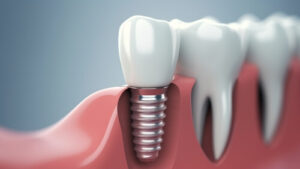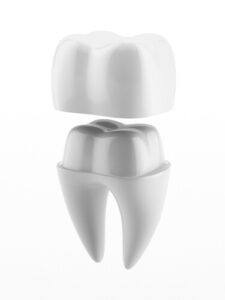Starting on the journey of dental implant healing stages, each pivotal for the success and longevity of the implant. Understanding these dental implant healing stages is essential for patients, offering insights into what happens beneath the surface from when the implant is placed to full integration with the jawbone. This process, fascinating in its complexity, involves careful monitoring and patient cooperation.
Join us as we unravel the mystery behind the healing phases, highlighting the body’s remarkable capacity to heal and integrate dental implants, ensuring a foundation as solid as natural teeth. With meticulous care and expert guidance, this path leads to the restoration of a tooth and the renewal of confidence and function.
Introduction to Dental Implant Healing Stages
Dental implant surgery offers a promising pathway to restoring missing teeth. It closely mimics the function and appearance of natural teeth. The journey from tooth loss to a fully functional dental implant involves carefully orchestrated healing stages.
Understanding these stages is essential for anyone considering or undergoing dental implant treatment, as it sheds light on the intricate process and what to expect. From the surgical placement of the implant to the final restoration of the missing tooth, each step is critical for ensuring the success and longevity of the dental implant.
Initial Consultation and Planning: Before the procedure, a thorough assessment of oral health, bone density, and implant site preparation is essential.
Surgical Implantation: The implant is surgically placed into the jawbone under local anesthesia, marking the start of the healing journey.
Osseointegration Process: This is a critical phase where the implant integrates with the jawbone, creating a strong foundation for the replacement tooth.
Healing Cap or Abutment Placement: After osseointegration, a healing cap or abutment is attached to the implant, preparing it for the final crown.
Soft Tissue Healing: The gums around the implant heal and shape themselves, ensuring a natural look and feel.
Final Restoration: The dental crown, modelled to match surrounding teeth, is attached to the implant, completing the restoration process.
Post-Operative Care and Monitoring: Good oral hygiene and regular dental check-ups are vital to monitor the implant and prevent complications.
Long-Term Maintenance: To ensure the longevity of the implant, maintaining good oral hygiene and avoiding harmful habits is crucial.
The Immediate Post-Surgical Phase: What to Expect
The immediate post-surgical phase following dental implant surgery is a critical period of dental implant recovery, where understanding and managing expectations become paramount for patients. This initial stage of healing is marked by specific symptoms and care requirements, which, when adequately addressed, can significantly impact the overall success of the dental implant.
During this time, patients are guided through a recovery process with detailed aftercare instructions to promote healing, minimise discomfort, and prevent infection. Recognising what to expect in this phase helps patients prepare for the journey ahead, ensuring a smoother transition through the subsequent stages of dental implant healing.
Immediate Aftercare
Instructions typically include advice on managing swelling and bruising with cold compresses, dietary restrictions to soft foods, and avoiding strenuous activity to prevent bleeding or implant displacement.
Pain Management
Mild to moderate discomfort is normal and often managed with prescribed pain medication or over-the-counter analgesics. It’s important to follow the oral surgeon’s advice on medication use.
Oral Hygiene Practices
Maintaining clean oral environments is crucial. Patients are usually advised to gently rinse with warm salt water or prescribed antimicrobial mouthwash to promote healing and prevent infection.
Monitoring for Complications
Recognising signs of potential complications such as excessive bleeding, severe pain, or signs of infection is critical. Patients are encouraged to contact their dental professional if they experience any concerning symptoms.
Follow-up Visits
Scheduled check-ups allow the dental professional to monitor the healing process, ensuring the implant integrates correctly and that the gum tissue is healing properly.
Osseointegration: The Key to Implant Stability

Biological Process
Osseointegration refers to the direct structural and functional connection between living bone and the surface of a load-bearing artificial implant. It involves the bone cells growing around and attaching to the titanium implant, a material chosen for its biocompatibility and ability to fuse with bone.
Critical Factors for Success
Several factors influence the success of osseointegration, including the quality and density of the patient’s jawbone, the implant’s material and surface texture, and the individual’s overall health and lifestyle habits. Smoking, for example, can significantly hinder the osseointegration process.
Timeline for Healing
The osseointegration phase generally lasts 3 to 6 months, but it varies from person to person. During this time, excessive force or movement must not disturb the implant to ensure successful bonding with the bone.
Monitoring Progress
Regular follow-up visits with the dental professional are essential during osseointegration. These appointments allow the dentist to monitor the implant’s integration with the jawbone and address any issues promptly.
Patient’s Role in Osseointegration
Adhering to post-operative care instructions, maintaining good oral hygiene, and avoiding certain activities or habits that could jeopardise implant stability are crucial during this healing phase. Patients are advised to follow a soft diet, avoid smoking, and practice gentle but effective oral hygiene.
Soft Tissue Healing: Gums and the Role They Play

The interplay between soft tissue healing and implant stability underscores the need for diligent post-operative care to promote optimal dental health and healing.
Initial Response and Healing
Right after implant placement, the body initiates a healing response. The gums start to repair themselves, forming new tissue that must securely adhere to the implant’s surface to create a tight seal.
Managing Inflammation
While inflammation is a normal part of healing, excessive swelling can indicate complications. Patients are advised to follow their dentist’s recommendations for managing inflammation, such as using ice packs and maintaining oral cleanliness to facilitate smooth healing.
Tissue Maturation
Over weeks to months, the soft tissues around the implant mature and strengthen. This period is crucial for developing a durable gum line that can resist the forces of chewing and protect the implant.
Monitoring for Gum Health
Regular check-ups with the dental professional are essential to ensure the gums are healing correctly and to identify any signs of peri-implantitis early. These visits may include cleaning the implant site and adjusting care routines.
Oral Hygiene Practices
Effective oral hygiene practices are vital during this stage. Patients should gently clean around the implant site as instructed by their dental professional to prevent infection and promote healthy tissue integration.
Monitoring and Managing Pain and Swelling

Immediate Post-Operative Care: Initially, managing pain and swelling involves applying cold packs to the cheek area near the surgical site intermittently for the first 24-48 hours to reduce swelling.
Medication for Pain Management: Pain relief is commonly achieved through prescribed painkillers or over-the-counter medications. It’s important to follow the dental professional’s instructions regarding dosage and frequency to manage discomfort effectively.
Elevation and Rest: Patients are advised to rest with their heads elevated for the first few days post-surgery. This position helps reduce swelling and promotes faster recovery.
Dietary Adjustments: Consuming soft foods and avoiding hot beverages can help manage pain and swelling. Cold foods and drinks are particularly beneficial in the immediate healing phase.
Oral Hygiene and Salt Water Rinses: Properly cleaning and using salt water rinses (as recommended by the dentist) can aid in healing and reduce the risk of infection, which can minimise pain and swelling.
Monitoring for Excessive Swelling or Pain: While some degree of pain and swelling is normal, excessive or prolonged symptoms may indicate an issue. Patients should promptly report any concerns to their dental professional for further assessment.
The Role of Oral Hygiene in Healing Success

Antimicrobial Rinses: Starting the day after surgery, patients are often advised to gently rinse with prescribed antimicrobial mouthwashes or a saltwater solution to cleanse the area and reduce the risk of infection.
Soft Bristle Brushing: A soft-bristled toothbrush allows careful cleaning around the implant site. Patients should begin brushing the adjacent teeth as soon as they are comfortable, gradually including the implant site as healing permits.
Avoidance of Hard and Sticky Foods: In the initial weeks following surgery, avoiding hard, sticky, or chewy foods can prevent undue pressure on the implant site and aid in the healing process.
Regular Dental Check-ups: Scheduled follow-ups with the dental professional are vital for monitoring healing progress. These appointments may include professional cleaning around the implant to remove plaque buildup without harming the healing tissues.
Smoking Cessation: Smoking significantly hampers the healing process and increases the risk of implant failure. Patients are strongly encouraged to quit or reduce smoking during the healing period.
Nightly Flossing: Once the dentist advises, gentle flossing around the implant helps remove plaque and debris, further preventing gum disease and promoting healthy tissue integration.
Check-ups and Adjustments: Navigating the Healing Timeline
Regular check-ups and adjustments are crucial for a smooth recovery following dental implant surgery. These visits enable the oral surgeon and the dental team to oversee the healing process, make necessary modifications, and address any issues promptly, playing a key role in the implant’s success.
Immediate Post-Operative Assessments: The first follow-up, typically a few days post-surgery, allows the dentist to check for infection signs, confirm the implant’s correct placement, and review pain management effectiveness.
Osseointegration Monitoring: Subsequent visits focus on the osseointegration process, where the implant fuses with the jawbone. This critical phase determines the implant’s stability and may require several months. Check-ups are scheduled to track progress.
Prosthetic Adjustments: As healing progresses, adjustments to temporary prosthetics may be needed for comfort and function. These adjustments ensure that the bite remains aligned and that there is no undue pressure on the implant site.
Gum Health Evaluation: The gums around the implant are assessed for proper healing. The dentist may guide improving oral hygiene practices to support healthy gum tissue and prevent peri-implant diseases.
Final Restoration Fitting: Once healing is successful, the final prosthetic, such as a crown, bridge, or denture, is fitted. This stage may involve several fittings to ensure the replacement teeth are comfortable, aesthetically pleasing, and fully functional.
Long-term Maintenance: Beyond the initial healing period, regular dental check-ups are vital for the implant’s long-term success. These appointments allow for the early detection and management of complications, ensuring the implant remains healthy and functional.
The Final Stage: Abutment Placement and Prosthetic Restoration

Abutment Placement: This step involves fixing the abutment, a vital connector piece, onto the implant post. Depending on whether a healing cap was used, the procedure might require reopening the gum line to access the implant. The choice of abutment is tailored to match the implant type and the specific needs of the prosthetic.
Healing and Gum Adjustment: Post-abutment placement, a brief healing period is necessary for the gums to properly heal and mould around the abutment. This phase is crucial for creating a natural-looking gum line around the prosthetic tooth.
Prosthetic Fabrication: Concurrently, dental technicians meticulously craft the final prosthetic (crown, bridge, or denture) based on impressions taken of the patient’s mouth. This ensures a custom fit complements the patient’s bite, facial structure, and aesthetic preferences.
Fitting the Prosthetic: The custom-made prosthetic is securely attached to the abutment. This process may involve several fittings to fine-tune the prosthetic for comfort, function, and appearance, ensuring the replacement tooth feels natural and performs optimally.
Final Adjustments and Care Instructions: Once the prosthetic is fitted, the dentist may make final adjustments for bite alignment and provide care instructions. This includes proper cleaning techniques and scheduling follow-up visits to monitor the implant’s health and functionality.
Going through the dental implant healing stages is a step-by-step process that needs patience and care. Each phase is important for the implant’s success, from right after the initial surgery to when you get your new tooth. It’s a team effort between you and your dentist to give you back your smile and confidence. Taking good care of yourself during these stages can make a big difference in getting a lasting solution to tooth loss.
Ready to start your journey towards a new smile with dental implants? If you have any questions about the dental implant healing stages or want to know more about dental crowns and how we can help, don’t hesitate to call us at Digital Dental Surgery Sydney on (02) 8294 5812. Our friendly team is here to guide you through each step, ensuring you feel confident and informed from start to finish. Reach out today, and let’s take the first step together towards restoring your smile.
References
Dental implant surgery
https://www.mayoclinic.org/tests-procedures/dental-implant-surgery/about/pac-20384622
Dental Implants: Surgery, Advantages, Risks, & Insurance
https://www.webmd.com/oral-health/dental-implants
What are dental implants? Types, procedures, and more
https://www.medicalnewstoday.com/articles/327515
Dental Implants: What You Should Know
https://www.fda.gov/medical-devices/dental-devices/dental-implants-what-you-should-know
Dental Implants – StatPearls
https://www.ncbi.nlm.nih.gov/books/NBK470448/






